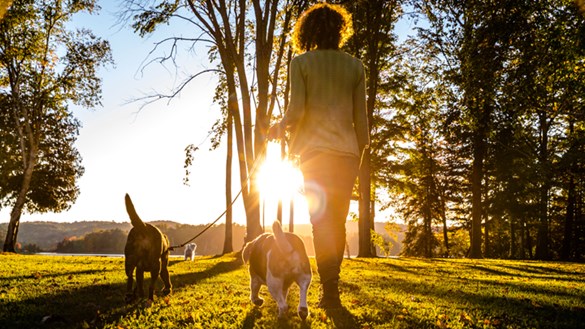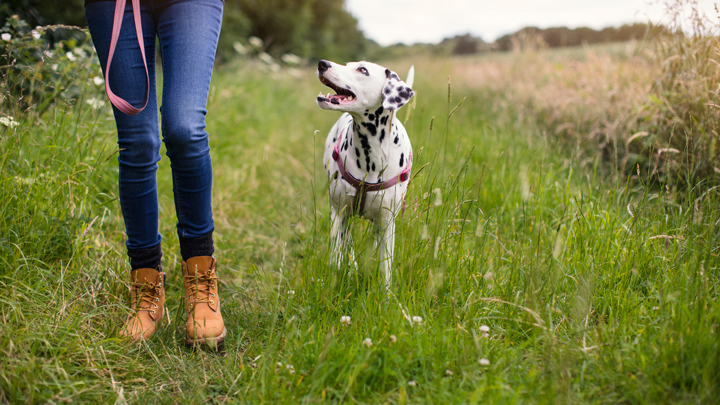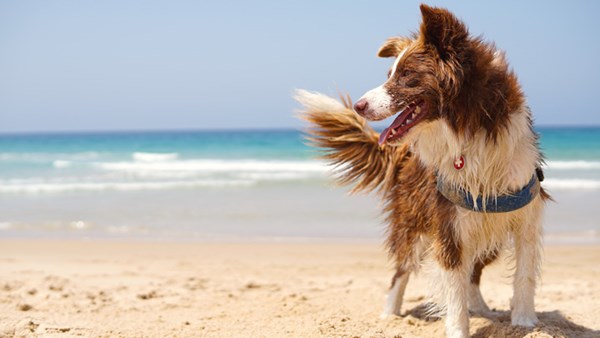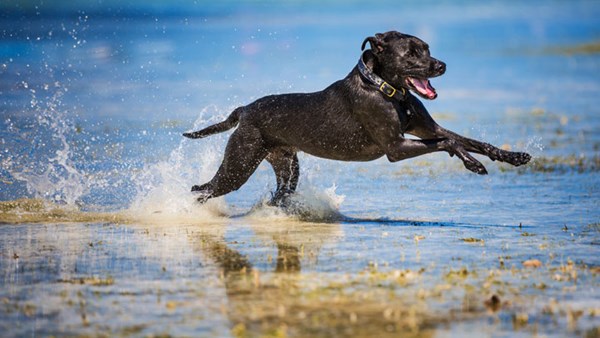Walking Your Dog In Summer
Bright mornings and light evenings are perfect for getting out more with your dog, read our advice and tips on getting the most out of summer walks.

Make the most of it
With many of us having adjusted our regular routines due to the Covid restrictions many dogs have benefited, not only from the extra company at home but also through more regular walks. However, as restrictions ease and the weather improves, it presents a great opportunity to keep up the regular walks when it isn’t too hot.
Walking your dog is beneficial to both of you; you get to spend time with each other and you both get some exercise in the fresh air. It’s a win/win situation.
Try somewhere different
Summer is an ideal season to try walking somewhere different. It doesn’t need to be too far afield; we recommend that you keep car journeys to a minimum. Your dog will appreciate all of the new smells and it’s a great opportunity for you to explore too.
Avoid long pavement walks if you can, they’re not very exciting for you or your dog.
Relaxing for you both
When you’re out walking your dog, it’s a great opportunity to take a break from your screen, whether that’s your mobile, computer or the television. Enjoy the time together and notice what’s going on around you, it’s also a great way to interact with other dog-walkers, maybe even get some tips for the best places to walk.
While many dogs enjoy ball games – your dog will also enjoy just pottering along with you. Try not rush to the point where they can be off the lead and see if there are any new trees or bushes that they’ve not sniffed yet.

How long should I walk my dog for?
There are many factors that need to be considered including your dog’s age, breed, health – as well as factors like the weather. However, all dogs should be taken out for a minimum of one decent walk a day, even if they have the run of the garden. Walking is a great stress reliever for dogs and will help to keep their brains active and have a positive impact on weight control.
Aim for a couple of walks a day. Talk to your vet about how long those walks should be if you’re not sure. You can generally gauge this by what your dog is like after each walk.
If it’s a warm day, then this changes – see our tips below on walking your dog when the weather is hot.
Tips to enjoy a safe walk
- Plan ahead– if you decide to try a new route, it’s a good idea to research the route to avoid getting lost.
- Stay safe – take your phone but try and avoid focussing on the phone and not your dog.
- Let your dog sniff their way along and investigate the hedgerows. Sniffing can help to reduce your dog’s stress and it gives you the opportunity to take everything in.
- Take your own ball or toy for games of fetch; it’s safer to bring your own - as sticks can result in severe injuries to a dog’s mouth or throat. If your dog can’t resist the sticks and branches that they come across, avoid throwing these for them. You should also check them for sharp edges if your dog decides to carry them.
- It’s worth having access to a few treats that can be used to encourage your dog to make their way back to you as required.
- At the end of your walk, check your dog over for any unwanted guests that they may have picked up on route; ticks, fleas etc. You should also check their paws and ears for grass seeds if they have been in long grass.
Tips for walking your dog on hot days
It’s good practice to always be prepared when you take your dog for a walk, but in warmer weather, there are a few extra things that you can do to ensure that your dog stays happy and healthy. Dogs can overheat very quickly and with serious consequences.
- Avoid the heat of the day – it’s best to walk your dog either first thing in the morning or later in the day. Keep walks shorter than normal, your dog needs to get out but not for too long.
- Try and find a route that is at least partially shaded. This allows your dog to walk and exercise in areas that may be a little cooler.
- Ensure that your dog has access to plenty of fresh water that they can drink along the way. Hydration becomes even more important when the temperature rises.
- Look out for signs of overheating. Bear in mind that it doesn’t have to be full on heat for it to be too much for your dog. If they start panting, this is their body trying to cool them down.
- Avoid strenuous games of fetch or running around with other dogs. The temptation for your dog to play might be too much if they are off the lead around other dogs.
- Apply a specially formulated sunscreen. If your dog is white or fair, you should apply sunscreen to sensitive areas such as their ears.
- If you have travelled by car, your dog will appreciate an iced bottle of water as a cooling aide as you make your way home.
Looking for some ideas?
If you’re looking for inspiration for new places to walk, most local areas will have a website that will hopefully lead you to some hidden gems that aren’t too far from home.
Alternatively, the National Trust also provides details on dog-walks both local and across the UK.



